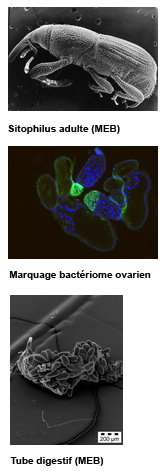Image

Research groups
 Intracellular symbiotic bacteria (endosymbionts) of the weevil Sitophilus highly contribute to the destructive power of this cereal pest, as they complement the host diet with metabolic components lacking in cereal grains (e.g. amino acids and vitamins). As mitochondria, endosymbionts are transmitted maternally (via oocytes) to the offsprings. Early during embryonic development, endosymbionts induce the differentiation of specialized host cells called the bacteriocytes, which group together to form the bacteriome organ in larvae. The bacteriocytes house endosymbionts and protect them against the insect immune response. Bacteria are only tolerated inside these specific cells, and their externalization from the bacteriocytes results in a drastic humoral immune response that sanctions endosymbionts. In adults, endosymbionts are housed within the bactériomes of mesenteric ceca of the midgut. Their number increases dramatically during the first week after adult molting. Remarkably, adults are completely devoid of gut endosymbionts two weeks later, while they keep ovary endosymbionts for transmission to offsprings. This biological phenomenon is being elucidated.
Intracellular symbiotic bacteria (endosymbionts) of the weevil Sitophilus highly contribute to the destructive power of this cereal pest, as they complement the host diet with metabolic components lacking in cereal grains (e.g. amino acids and vitamins). As mitochondria, endosymbionts are transmitted maternally (via oocytes) to the offsprings. Early during embryonic development, endosymbionts induce the differentiation of specialized host cells called the bacteriocytes, which group together to form the bacteriome organ in larvae. The bacteriocytes house endosymbionts and protect them against the insect immune response. Bacteria are only tolerated inside these specific cells, and their externalization from the bacteriocytes results in a drastic humoral immune response that sanctions endosymbionts. In adults, endosymbionts are housed within the bactériomes of mesenteric ceca of the midgut. Their number increases dramatically during the first week after adult molting. Remarkably, adults are completely devoid of gut endosymbionts two weeks later, while they keep ovary endosymbionts for transmission to offsprings. This biological phenomenon is being elucidated.